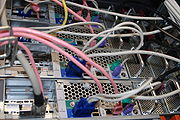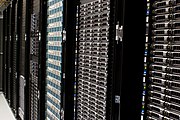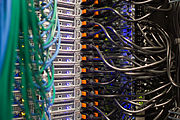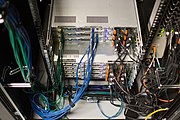A
server is a system (
software and suitable
computer hardware) that responds to requests across a
computer network to provide, or help to provide, a
network service.
Servers can be run on a dedicated computer, which is also often
referred to as "the server", but many networked computers are capable of
hosting servers. In many cases, a computer can provide several services
and have several servers running.
Servers operate within a
client-server architecture, servers are computer programs running to serve the requests of other programs, the
clients.
Thus, the server performs some task on behalf of clients. The clients
typically connect to the server through the network but may run on the
same computer. In the context of
Internet Protocol (IP) networking, a server is a program that operates as a
socket listener.
Servers often provide essential services across a network, either to
private users inside a large organization or to public users via the
Internet. Typical computing servers are
database server,
file server,
mail server,
print server,
web server,
gaming server,
application server, or some other kind of server.
Numerous systems use this client / server networking model including Web sites and email services. An alternative model,
peer-to-peer networking enables all computers to act as either a server or client as needed.
Usage
The term
server is used quite broadly in
information technology.
Despite the many server-branded products available (such as server
versions of hardware, software or operating systems), in theory any
computerised process that shares a resource to one or more client
processes is a server. To illustrate this, take the common example of
file sharing.
While the existence of files on a machine does not classify it as a
server, the mechanism which shares these files to clients by the
operating system is the server.
Similarly, consider a web server application (such as the
multiplatform "
Apache HTTP Server"). This web server software can be
run on any capable
computer. For example, while a
laptop
or personal computer is not typically known as a server, they can in
these situations fulfill the role of one, and hence be labelled as one.
It is, in this case, the machine's role that places it in the category
of server.
In the hardware sense, the word
server typically designates computer models intended for hosting
software applications under the heavy demand of a
network environment. In this
client–server configuration one or more machines, either a computer or a
computer appliance, share information with each other with one acting as a
host for the other[s].
While nearly any
personal computer
is capable of acting as a network server, a dedicated server will
contain features making it more suitable for production environments.
These features may include a faster
CPU, increased high-performance
RAM, and increased storage capacity in the form of a larger or multiple
hard drives. Servers also typically have
reliability, availability and serviceability (RAS) and
fault tolerance features, such as
redundancy in
power supplies, storage (as in
RAID), and network connections.
Servers became common in the early 1990s as businesses increasingly
began using personal computers to provide services formerly hosted on
larger
mainframes or
minicomputers. Early file servers housed multiple
CD-ROM drives, which were used to host large
database applications.
[citation needed]
Between the 1990s and 2000s an increase in the use of
dedicated hardware saw the advent of self-contained
server appliances. One well-known product is the
Google Search Appliance, a unit that combines hardware and software in an out-of-the-box packaging. Also produced were the
Cobalt Qube and the
RaQ. Simpler examples of such appliances include
switches,
routers,
gateways, and
print servers, all of which are available in a near
plug-and-play configuration.
Modern
operating systems such as
Microsoft Windows or
Linux distributions seem to be designed with a
client–server architecture in mind. These operating systems attempt to
abstract hardware, allowing a wide variety of software to work with components of the computer. In a sense, the operating system can be seen as
serving hardware to the software, which in all but
low-level programming languages must interact using an
API.
These operating systems may be able to run programs in the background called either
services or
daemons. Such programs, such as the aforementioned
Apache HTTP Server software, may wait in a
sleep state for their necessity to become apparent. Since any software that provides services can be
called a server, modern personal computers can be seen as a forest of servers and clients operating in
parallel.
The
Internet itself is also a forest of servers and clients. Merely requesting a
web page from a few kilometers away involves satisfying a
stack of
protocols that involve many examples of hardware and software servers. The least of these are the
routers,
modems,
domain name servers, and various other servers necessary to provide us the
world wide web.
The introduction of
Cloud computing allows server storage and other resources to be shared in a pool and provides servers with a higher degree of fault tolerance.
Server hardware
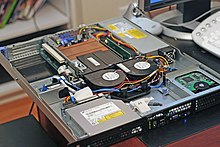
A rack-mountable server. Top cover removed to reveal the internal components.
Hardware
requirement for servers vary, depending on the server application.
Absolute CPU speed is not quite as critical to a server as it is to a
desktop machine
[citation needed].
Servers' duties to provide service to many users over a network lead to
different requirements such as fast network connections and high I/O
throughout. Since servers are usually accessed over a network, they may
run in
headless mode without a
monitor or input device. Processes that are not needed for the server's function are not used. Many servers do not have a
graphical user interface (GUI) as it is unnecessary and consumes resources that could be allocated elsewhere. Similarly, audio and
USB interfaces may be omitted.
Servers often run for long periods without interruption and
availability
must often be very high, making hardware reliability and durability
extremely important. Although servers can be built from commodity
computer parts,
mission-critical enterprise servers are ideally very fault tolerant and use specialized hardware with low
failure rates in order to maximize
uptime,
for even a short-term failure can cost more than purchasing and
installing the system. For example, it may take only a few minutes of
down time at a national
stock exchange
to justify the expense of entirely replacing the system with something
more reliable. Servers may incorporate faster, higher-capacity hard
drives, larger
computer fans or
water cooling to help remove heat, and
uninterruptible power supplies
that ensure the servers continue to function in the event of a power
failure. These components offer higher performance and reliability at a
correspondingly higher price. Hardware
redundancy—installing more than one instance of modules such as
power supplies and
hard disks arranged so that if one fails another is automatically available—is widely used.
ECC memory devices that detect and correct errors are used; non-ECC memory is more likely to cause data corruption.
[3]
To increase reliability, most servers use memory with
error detection and correction,
redundant disks, redundant power supplies and so on. Such components are also frequently
hot swappable,
allowing technicians to replace them on the running server without
shutting it down. To prevent overheating, servers often have more
powerful fans. As servers are usually administered by qualified
system administrators, their operating systems are also more tuned for stability and performance than for user friendliness and ease of use,
Linux taking a noticeably larger percentage than for desktop computers.
[citation needed]
As servers need a stable power supply, good Internet access,
increased security and are also noisy, it is usual to store them in
dedicated
server centers
or special rooms. This requires reducing the power consumption, as the
extra energy used generates more heat thus causing the temperature in
the room to exceed acceptable limits; hence normally, server rooms are
equipped with air conditioning devices. Server casings are usually flat
and wide (typically measured in "
rack units"), adapted to store many devices next to each other in a
server rack. Unlike ordinary computers, servers usually can be configured, powered up and down or rebooted remotely, using
out-of-band management, typically based on
IPMI.
Many servers take quite a long time for the hardware to start up and load the operating system. Servers often do extensive
pre-boot memory testing and verification and startup of remote management services. The
hard drive controllers
then start up banks of drives sequentially, rather than all at once, so
as not to overload the power supply with startup surges, and afterwards
they initiate
RAID
system pre-checks for correct operation of redundancy. It is common for
a machine to take several minutes to start up, but it may not need
restarting for months or years.
Server operating systems
Server-oriented operating systems tend to have certain features that make them more suitable for the server environment, such as
[citation needed]
- GUI not available or optional
- ability to reconfigure and update both hardware and software to some extent without restart,
- advanced backup facilities to permit regular and frequent online backups of critical data,
- transparent data transfer between different volumes or devices,
- flexible and advanced networking capabilities,
- automation capabilities such as daemons in UNIX and services in Windows
- tight system security, with advanced user, resource, data, and memory protection.
Server-oriented operating systems can, in many cases, interact with
hardware sensors to detect conditions such as overheating, processor and
disk failure, and consequently alert an operator or take remedial
measures themselves.
[4]
Because servers must supply a restricted range of services to perhaps
many users while a desktop computer must carry out a wide range of
functions required by its user, the requirements of an operating system
for a server are different from those of a desktop machine. While it is
possible for an operating system to make a machine both provide services
and respond quickly to the requirements of a user, it is common to use
different operating systems on servers and desktop machines. Some
operating systems are supplied in both server and desktop versions with
similar user interface
Windows and
Mac OS X server operating systems are deployed on a minority of servers, as are other proprietary
mainframe operating systems, such as
z/OS. The dominant operating systems among servers are UNIX-like
open source distributions, such as those based on
Linux and
FreeBSD.
[5] The rise of the
microprocessor-based server was facilitated by the development of Unix to run on the
x86 microprocessor
architecture. The
Microsoft Windows family of operating systems also runs on x86 hardware and, since
Windows NT, have been available in versions suitable for server use
[citation needed].
While the role of server and desktop operating systems remains
distinct, improvements in the reliability of both hardware and operating
systems have blurred the distinction between the two classes. Today,
many desktop and server operating systems share similar
code bases, differing mostly in configuration. The shift towards
web applications and
middleware platforms has also lessened the demand for specialist application servers
Types of servers
In a general network environment the following types of servers may be found
- Application server, a server dedicated to running certain software applications
- Catalog server, a central search point for information across a distributed network
- Communications server, carrier-grade computing platform for communications networks
- Compute server, a server intended for intensive (esp. scientific) computations
- Database server, provides database services to other computer programs or computers
- Fax server, provides fax services for clients
- File server, provides remote access to files
- Game server, a server that video game clients connect to in order to play online together
- Home server, a server for the home
- Mail server, handles transport of and access to email
- Mobile Server, or Server on the Go is an Intel Xeon processor based server class laptop form factor computer.
- Name server or DNS
- Print server, provides printer services
- Proxy server, acts as an intermediary for requests from clients seeking resources from other servers
- Sound server, provides multimedia broadcasting, streaming.
- Stand-alone server, a server on a Windows network that neither belongs to nor governs a Windows domain
- Web server, a server that HTTP clients connect to in order to send commands and receive responses along with data contents
Almost the entire structure of the
Internet is based upon a
client–server model. High-level
root nameservers,
DNS,
and routers direct the traffic on the internet. There are millions of
servers connected to the Internet, running continuously throughout the
world.
[6]
Virtually every action taken by an ordinary
Internet user requires one or more interactions with one or more servers.
There are also technologies that operate on an
inter-server level. Other services do not use dedicated servers; for example
peer-to-peer file sharing, some implementations of
telephony (e.g.
Skype), and supplying television programs to several users (e.g.
Kontiki,
SlingBox)
[citation needed].
Energy consumption of servers
In 2010, data centers (servers, cooling, and other electrical
infrastructure) were responsible for 1.1-1.5% of electrical energy
consumption worldwide and 1.7-2.2% in the
United States.
To put this in context, this is less than the 6 billion cell phones
in the world use to recharge their batteries. Moreover, this pales in
comparison to double-digit uses like heating and cooling, domestic hot
water, ranges, ovens, and clothes dryers, to name a few. Finally, to
keep this use in perspective, the Smart2020 report estimates that ICT
(Information and Communications Technology) saves more than 5 times its
carbon footprint in the rest of the economy by enabling efficiency.
Size classes
Sizes include
:

